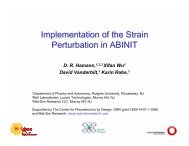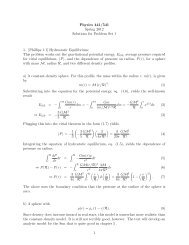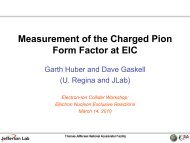Statistics of redshift periodicities
Statistics of redshift periodicities
Statistics of redshift periodicities
Create successful ePaper yourself
Turn your PDF publications into a flip-book with our unique Google optimized e-Paper software.
214 Current Issues in Cosmology<br />
0.6<br />
Count<br />
0.45<br />
0.3<br />
0.15<br />
0<br />
−211.2 −70.4 70.4 211.2 352 492.8<br />
velocity (km/sec)<br />
Figure 17.5 Velocities <strong>of</strong> 103 KM galaxies relative to a fixed solar apex as described<br />
in the text. Smoothed with a cut-<strong>of</strong>f at 15 km s −1 . There is a best-fit periodicity <strong>of</strong><br />
35.2 km s −1 .<br />
4 The QSO periodicity claim<br />
The third anomalous <strong>redshift</strong> claim tested so far is that QSOs in the neighborhood<br />
<strong>of</strong> bright, nearby, active spirals show a periodicity <strong>of</strong> 0.089 in log 10 (1 + z). There is<br />
some imprecision in the formulation <strong>of</strong> this hypothesis (what do we mean by close?<br />
By active? What phase should we associate with this periodicity, and with what<br />
standard errors?). The hypothesis was tightened up somewhat by bootstrap sampling<br />
<strong>of</strong> 116 QSOs used by Karlsson (1990)totest it, and fresh data were then employed<br />
as described in Burbidge and Napier (2001), alias BN: These comprised 57 QSO<br />
pairs with separations less than 10 arcseconds, 39 X-ray QSOs near active galaxies<br />
(comprising a complete sample), and 78 3C(R) radio QSOs, again comprising a<br />
virtually complete sample. Figure 17.6 is a histogram <strong>of</strong> the combined Karlsson and<br />
BN data sets: The periodicity is clearly present and seems to extend three cycles<br />
beyond that originally claimed. Monte Carlo trials yield a formal significance level<br />
<strong>of</strong> a few parts in 100 000, whether the null hypothesis is defined through smoothing<br />
<strong>of</strong> the given data or the z-distribution <strong>of</strong> QSOs as a whole.<br />
It has <strong>of</strong>ten been argued that the QSO periodicity is an artefact <strong>of</strong> observational<br />
selection effects (see the discussion in BN). However the data employed here<br />
were selected precisely to avoid such effects. It was also claimed that the result is<br />
a statistical artefact caused by edge effects (Hawkins et al. 2002), but this has been<br />
shown to be erroneous (Napier and Burbidge 2003): inter alia, edge effects were<br />
automatically allowed for in the procedures employed, and the periodicity is easily<br />
seen by eye, without any statistical analysis (Fig. 17.6). Again, however, although<br />
the periodicity is clear, the circumstances under which it arises are not. For example,



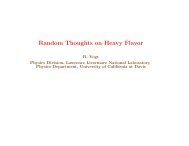

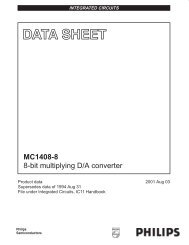

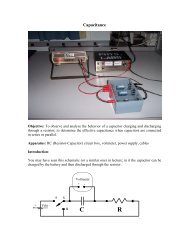


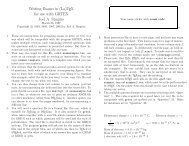
![More Effective C++ [Meyers96]](https://img.yumpu.com/25323611/1/184x260/more-effective-c-meyers96.jpg?quality=85)


